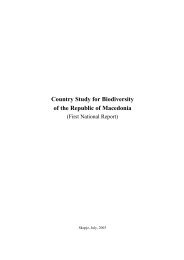CBD Fourth National Report - Azerbaijan (English version)
CBD Fourth National Report - Azerbaijan (English version)
CBD Fourth National Report - Azerbaijan (English version)
Create successful ePaper yourself
Turn your PDF publications into a flip-book with our unique Google optimized e-Paper software.
Country Study on Biodiversity and <strong>Fourth</strong> <strong>National</strong> <strong>Report</strong><br />
The Republic of <strong>Azerbaijan</strong><br />
taeniatus), Balic vimba (Vimba v. persa), Black Sea roach (Rutilus frisii kutum), common<br />
carp (Cyprinus c. carpio), North Caspian roach (Rutilus rutilus), Caspian bream (Abramis<br />
brama orientalis), Kura bleak (Chalcalburnus chalcoides guldenstadt) and Danubian bleak<br />
(Ch. chalcoides longissimus).<br />
Medical use<br />
Leeches (Hirudinea medicinalis) are used by the general public for the treatment of different<br />
diseases and hirudin 36 from leeches is considered to be a precious medical remedy. In<br />
addition, until the mid 1990’s a special institution existed to collect venom from the Levetine<br />
viper (Macrovipera lebetine) populations.<br />
There is a long history of the use of wild animals in Nakhichevan Autonomous Republic,<br />
including hunting of birds (such geese, ducks, bustards, quail, and partridge). Among the<br />
birds hunted in Nakhichevan are a number of locally endemic sub-species of non-migratory<br />
birds, which may be at particular risk from over-exploitation combined with loss of habitats<br />
and fires 37 . In addition, other species caught by the general population include mountain<br />
goats, mouflon, fox, wolf, jackal, and vipers (including Radde’s viper).<br />
A wide range of fish is caught within Nakhichevan’s rivers and lakes, particularly from the<br />
Araz River and reservoir. There is also fishing on the Iranian bank of the Araz. Fish<br />
populations have declined as a result of unsustainable offtake (particularly during the<br />
sensitive spawning period), use of illegal fishing devices, and overfishing from the Iranian<br />
side of the Araz reservoir) and as a result of pollution, changes in water composition and<br />
reduced invertebrate populations in the Araz River.<br />
3.1.2.3. Evaluation of sustainability of use of wild species<br />
The fauna and flora of different areas of <strong>Azerbaijan</strong> face different anthropogenic threats,<br />
resulting in inconsistent patterns of distribution of key biological resources. For example, the<br />
biological resources of the Caspian Sea are threatened as a result of its isolation from other<br />
oceans, and the intensity of pressure on its resources. In addition, the steppe and semi-deserts<br />
of the Kura-Araz and Absheron plains are threatened, as are the forest resources of the<br />
Greater and Lesser Caucasus Mountains. The regions with greater resilience to use of<br />
resources include the wetter areas in the subtropical regions (such as Astara and Lankaran),<br />
where the dry subtropical forests recover well and can be sustainably managed.<br />
At the same time, expansion of protected areas network enables rapid and effective<br />
rehabilitation of fauna resources of areas covered their scope (10.1% part of the country is<br />
comprised by protected areas).<br />
3.1.3. Use of biodiversity for biotechnology and genetic collections<br />
Biodiversity is used for scientific and industrial purposes through biotechnology. Genetic<br />
material is sourced from wild and cultivated plant species and is maintained in vitro for both<br />
conservation and scientific goals. Forms of tomato, tobacco, wheat and roses have been<br />
developed under laboratory conditions. In industry, genetic material from wild and cultivated<br />
plants is used to develop hybrids with specific characteristics.<br />
36 From the saliva glands of the leech<br />
37 Quail (Coturnix coturnix coturnix), rock partridge (Alectoris graeca jaujisijus), grey partridge (Perdix<br />
perdix janesjens), Caspian snowcock (Tetraogallus caucasicus taurijus).<br />
78<br />
2009

















